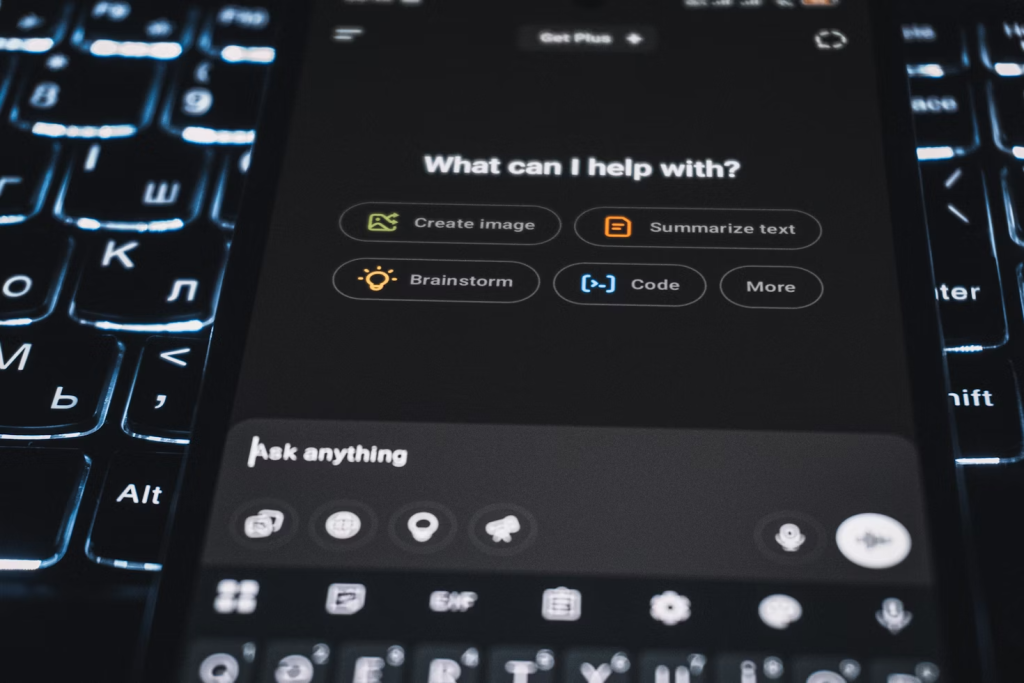
A Letter to the Young, Aspiring Marketer in the Age of AI
Let’s start with the obvious irony. I’m a 25-year marketing veteran, and I am currently collaborating with a generative AI-GPT-4o to be precise-to write a heartfelt, personal blog post about… how not to be replaced by generative AI.
If that doesn’t perfectly capture the weirdness of this moment, I don’t know what does.
This strange new world is exactly why I’m writing this. Twenty-five years ago, I walked into my first AMA Boston event trying to find my footing. I majored in economics, not marketing. That community was my anchor amid shifting tides. Back then, the internet was the massive disruptive force. One of my first roles was as a public relations helper. I did “helper stuff.” I sent press releases by fax, sat in on design meetings as “note taker”, and carried boxes for event teams. I learned by watching, by being there.
My next job was as a research analyst at a global PR agency on Boylston Street, where dot-coms were funneling in like keg stands on a Saturday night. Then I landed an actual marketing job in academic press publishing…and so began the stepping stones of my career–a path that was anything but linear, but one that I navigated with intention.
Today, the ground is shifting under our feet in a whole new way. I want to talk directly to the person who feels like they’re being made obsolete before they’ve even had a chance to begin.
Young marketers: you’re not imagining it. The data is in, but read on.
The Canary in the Coal Mine
A recent working paper from Stanford University, aptly titled “The AI Canaries,” confirmed what many of us suspected and were feeling intuitively: generative AI is having a disproportionate impact on early-career professionals. The entry-level tasks that were once the training ground for our entire industry—the research, the first drafts, the persona outlines-are now being automated with brutal efficiency.
For experienced marketers, these tools are like rocket fuel for our ideas. A go-to-market strategy that took weeks of research can now be outlined in an afternoon. It’s a massive accelerator.
But this creates a terrifying paradox for our freshman marketers. If AI is doing the “junior work,” how do you get the flight time you need to become a senior marketing pilot?
Our “Unfair” Advantage (And How to Steal It)
So why are senior marketers like me actually getting faster with these tools? It’s not magic. It’s because we’ve spent decades learning which questions to ask, and understanding the nuance involved.
The secret is this: a prompt is just a fancy word for a good question. And after 25 years, you get pretty good at asking them.
This isn’t a permanent advantage; it’s just a head start. Your job is to close that gap faster than anyone thinks you can. The goal isn’t to outsmart the algorithm; it’s to become the smartest human in the loop.
Flip the Script: Make AI Your Superpower
- Get Yourself a 24/7 AI Tutor (For Free)
As an early-career marketer, you don’t know what you don’t know. I believe this is the single biggest hurdle for any junior marketer. Use AI to leapfrog years of slow, painful learning. Don’t just ask it to do the work; ask it to teach you the work.
- “Explain the core components of a go-to-market strategy like I’m a high school student.”
- “What are five frameworks for creating the best customer personas? Compare their pros and cons.”
- “My boss mentioned ‘brand equity.’ What is that, give me some examples from different vertical markets, and what are the key metrics used to measure it?”
Be relentless. Be curious. Never stop asking. Show up to every project with a deeper understanding than anyone expects.
- Use AI to Slay the Blank Page
Don’t be tempted to ask AI to “write a blog post.” That’s a rookie move. Instead, use it as a powerful collaborator to destroy the paralysis of a blank page. Your value is not in the first draft; it’s in the strategic refinement. It’s about asking better questions, it’s getting at why it matters.
- “Generate ten compelling headlines for a blog post about the challenges facing first-time homebuyers in the north metro Boston area.”
- “My target audience is a risk-averse CFO. Give me five different angles to pitch a new marketing analytics software to them.”
- “Brainstorm a list of unconventional, creative, high-value/low-cost marketing tactics for a direct-to-consumer coffee brand in southern New England.”
AI gives you the raw clay, but you are the sculptor. Don’t make the mistake of giving GenAI tools the power over the finished product.
- Master the Art of the Prompt
A prompt isn’t a search query; it’s more like a creative brief. It’s a strategy document in miniature. The more context and constraints you provide, the better your output will be. Practice this relentlessly and assess the outputs with a critical eye.
- Assign a Persona: “You are a CMO with 20 years of experience in B2B software…”
- Provide Rich Context: “I am writing a marketing plan for a new mobile app that helps users track their personal carbon footprint…”
- Define the Format: “Give me the output in a table with three columns: Tactic, Target Audience, and Key Metric. Do not include social media marketing.”
- Double Down on Your Human Skills
AI is a fantastic collaborator, but it can’t have coffee with a client. It can’t read the room in a tense meeting. It can’t build trust with a colleague or feel a gut instinct that a campaign just isn’t landing right.
The most successful marketers in the AI era will be those who master the uniquely human skills: empathy, strategic relationship-building, creative intuition and problem-solving, and compelling storytelling. Use the time AI saves you on manual tasks to get better at the things the machine will never do. Go to the AMA networking events. Ask a senior leader for coffee. Spend extra time listening to sales calls. That is where true career-making chops are cut.
Your Free AI Starter Pack (as of Sept. 2025)
The number of tools is overwhelming. Ignore 99% of them. Start with these free, powerful resources.
For Writing & Brainstorming
-
ChatGPT (GPT-4o)
- Pro: The best all-around tool for creative writing, brainstorming, and complex problem-solving. It’s the most versatile “Swiss Army knife.”
- Con: Can still “hallucinate” or invent facts; always double-check its outputs for accuracy.
-
Google Gemini
- Pro: Excellent for research and planning due to its direct integration with Google Search. Great for summarizing articles or creating structured outlines.
- Con: Its creative writing style can sometimes feel a bit less natural or “human” compared to other models.
-
Claude 3 Sonnet
- Pro: Best for working with large documents. You can upload a big PDF or paste a lot of text and ask questions about it. Often has a more nuanced writing style.
- Con: The free version has usage limits, so you might get temporarily paused during very heavy use.
For Research & Synthesis
-
Perplexity AI
- Pro: Fantastic for getting quick, factual answers with direct links to the sources it used. The best tool for reliable research.
- Con: It’s a research engine, not a creative writer. Don’t ask it to write a blog post or marketing copy.
For Image & Graphic Creation
-
Canva (Magic Design): An indispensable tool for marketers, especially those like me without deep design skills. While its AI tools aren’t perfect, the free tier is a great starting point, and for about $15/month, the Pro plan is a rockstar.
- Pro: Perfectly integrated into a marketer’s workflow. You can generate an image and immediately use it in a social media template or presentation without leaving the platform.
- Con: The number of free image generation credits is limited, and its AI model isn’t always as powerful as others for highly complex prompts.
Affiliate-free author’s note: My Canva Pro subscription is the best money I spend each month, tied with my Spotify Premium Duo plan.
For Video & Audio
-
CapCut: Offers a surprisingly robust suite of free AI-powered video editing tools—like auto-captions, text-to-speech, and background removal—right in your browser. It’s consistently one of the most downloaded apps in the world, making it the unofficial editor for TikTok and Instagram Reels.
- Pro: Unbeatable value. It provides powerful, trend-focused video editing features for free and is incredibly easy to use on a phone.
- Con: It’s designed for short-form, vertical video (like TikToks and Reels). It’s not the right tool for long-form, horizontal corporate videos.
Author’s experience note: I’ve tried Descript, but for me, the AI tool isn’t there yet as of August 2025; keep trying, Descript product team!
Your Career is Just Beginning
The community I plugged into at AMA 25 years ago was about people helping people navigate change. That outlet is still high-voltage. We, as senior marketers, have a responsibility to mentor and guide the next generation through this shift. Find your community, whether it’s at an AMA event, a Slack channel, or a Reddit sub-thread.
The challenge is new, but as corny as this sounds, the solution is timeless: stay curious, keep learning, and don’t be afraid to ask the right questions—of your colleagues, your mentors, and now, your AI collaborator.
You have the most powerful tools in history at your fingertips. The opportunity is yours for the taking.


